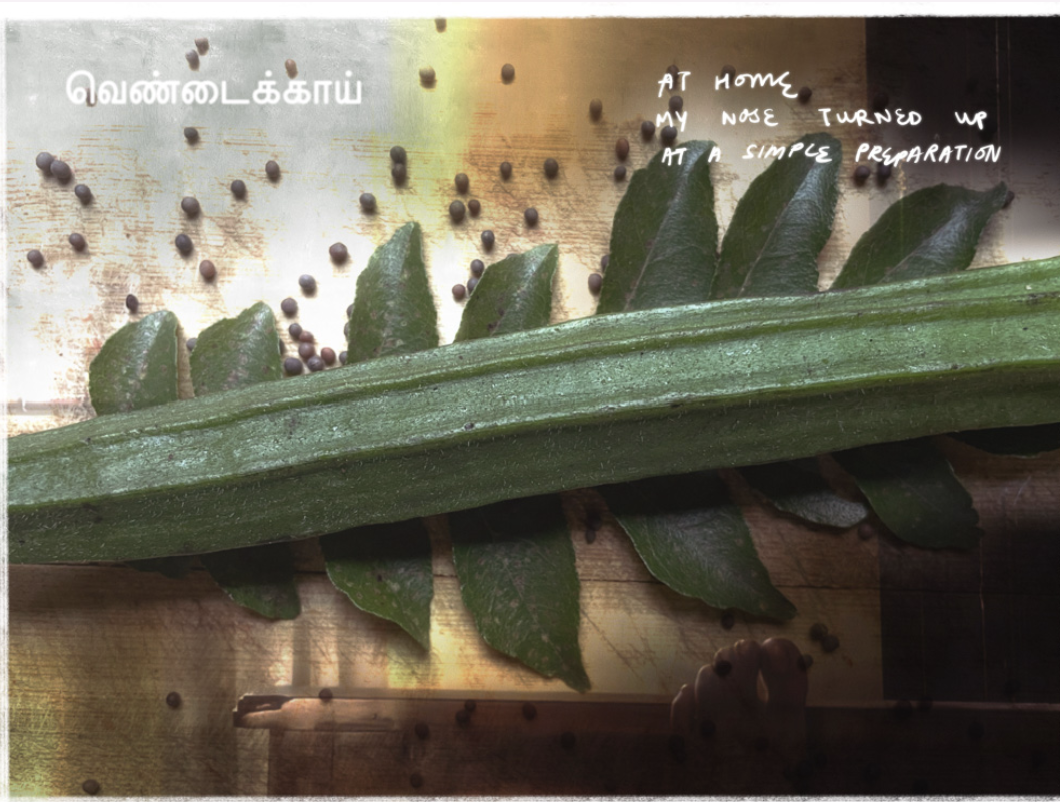WORDS BY Nikhita Venugopal
ILLUSTRATIONS BYLal Poster
Listen to this story. Narrated by Nikhita Venugopal.

The clouds that had gathered over the Chennai sky turned an ominous grey, an enduring sign that the monsoons were about to begin in full force. But before the downpour on that balmy evening in July, my grandmother and I walked through her front yard. While her two dogs raced around us, she pointed out additions to her ever-growing vegetable garden, some withering after bountiful months and others ready to spring anew. Egg-shaped white brinjals weighing on thin branches, pots of deep, verdant green coriander stems, a slim moringa tree dotted with delicate white flowers. But amid all that, one plant caught my attention. Familiar and unfamiliar at the same time, cylindrical tapering pods pointed up towards the sky from a bright green stalk, ready to be washed by the rain. The pods were soft to the touch, with a fine coating of delicate white fibre.

In Tamilzh, we call these pods vendakkai, though it is known by several other names in different languages, including okra, bhindi and lady’s finger.
It occurred to me that I hadn’t ever seen the plant up close before. Even to my own ears, the thought sounded absurd; a vegetable so deeply rooted in the kitchens of Indian families, and yet I had never imagined it rooted to the ground.
It is an unfortunate fact that lady’s fingers often get a bad rap. They’re either too slimy, too squishy, too soggy or taste like nothing. “As a kid in India, I hated bhindi”, a chef once told me, and he’s not the only one. Children in India have always had a distaste for okra. Beneath the angled exterior of the pods, its star-shaped insides hold numerous tiny seeds and a sticky substance called mucilage that can graciously be described as unpleasant (though okra aficionados will vehemently disagree). At home, my nose turned up at a simple preparation of lady’s fingers with curry leaves and mustard seeds.
It wasn’t until a few years ago that I began to appreciate the vegetable that I had once rejected. At one of my favourite bars in Bangalore, an order of okra podi chips would produce a mound of thinly sliced lady’s fingers shallow-fried in a light batter and tossed in the bar’s special podi, a heady mix of lentils and red chillies ground together to make a powder so explosive, it’s called gunpowder. If I could tell my younger self anything, I would say fried potatoes are cool, but wait till you try vendakkai.
Okra is a vegetable integral to Indian cooking, but its influence extends far beyond the country’s borders. Okra pods naturally lend themselves to frying, an undeniably delicious transformation from slime to sublime. In his 2019 cookbook South, Sean Brock says that the okra on his family table was always covered in cornmeal and thrown into hot oil (and paired swimmingly with tomato jam and hot sauce). It reminds me of a dish prepared on rare occasions in my home, where okra was cut into cubes, drenched in a thick concoction of masalas, and fried.
But once your palate is ready for okra’s true taste — unmasked by oil and batter — a sweet, snappy, grassy flavour awaits you. In its steamed form, okra retains its delectable crunch, while a quick stir-fry allows its brightness to shine through. Okra’s presence in the US dates back to the 1700s, and its recipes carry a long tradition. From how it’s cubed and simmered with onions, bell peppers, and celery to make gumbo, to how it pairs with lima beans, fresh corn, and tomatoes to make succotash. Writer and historian Michael W. Twitty has described a peppery okra soup with tomatoes and red pepper inspired by early 19th century recipes.
In the American south, okra holds a deep connection to the lives and history of Black Americans. Though there’s a somewhat tricky debate around the origins of okra, it’s widely accepted that the vegetable was first domesticated in Africa, before being carried on slave ships to the Deep South in the United States.

There are also theories that propose okra’s roots lie in parts of south Asia, given how many different kinds can be found over the subcontinent. “A handful of wild relatives distributed between Africa and Asia form the basis of the dispute over okra’s true origin,” writes Chris Smith in his James Beard award-winning book, The Whole Okra. Globally, India continues to be the top producing country for okra, at about six million tonnes per year, and the National Bureau of Plant Genetic Resource in New Delhi holds thousands of varieties. Nigeria comes in second with nearly two million tonnes annually. “One conclusion that partially satisfies both sides of the debate is that Asia is the likely ‘ancestral home’ of A. esculentus, but the okra was domesticated in East Africa,” adds Smith.
Ultimately, it’s hard to say why that really matters, except to underline that okra has a home in many black and brown kitchens around the world – a vegetable that stretches across oceans. In Southeast Asia, okra is sliced and stir-fried or steamed with sambal oelek, fresh chilis and oyster sauce. In Turkey, dried okra is added to a lamb-based soup called bamya.
It’s been years since I’ve stopped shying away from making okra at home. Sometimes, in a pale attempt at my favourite okra podi chips, I toss strips of lady’s fingers into a mix of chickpea flour and chilli powder before cooking them in the air fryer and adding a squeeze of lime to serve. But somehow, these days, when I think of lady’s fingers, I come back to a recipe far more rooted in both freshness and familiarity.
During that trip to Chennai, my grandmother slow-cooked mutton with chopped okra, straight from her garden, in a thick tomato-based masala. I probably wouldn’t have eaten it as a child, but roots are peculiar that way. No matter how hard you try to run away from them, your taste buds inevitably catch up with you.

